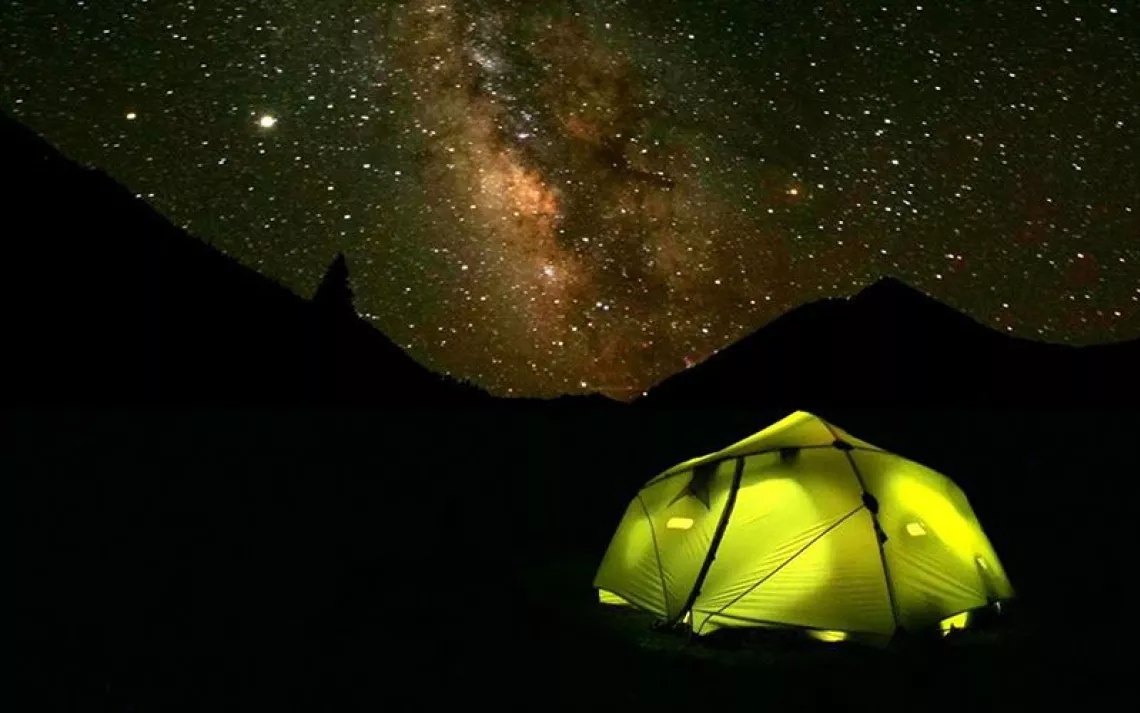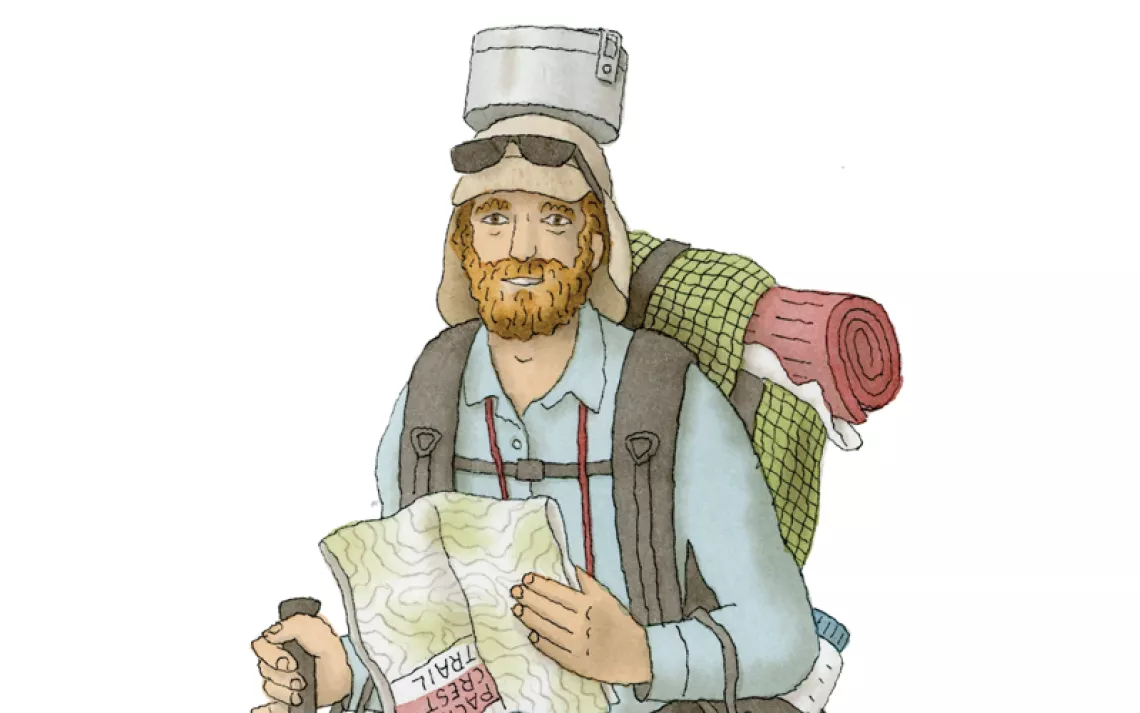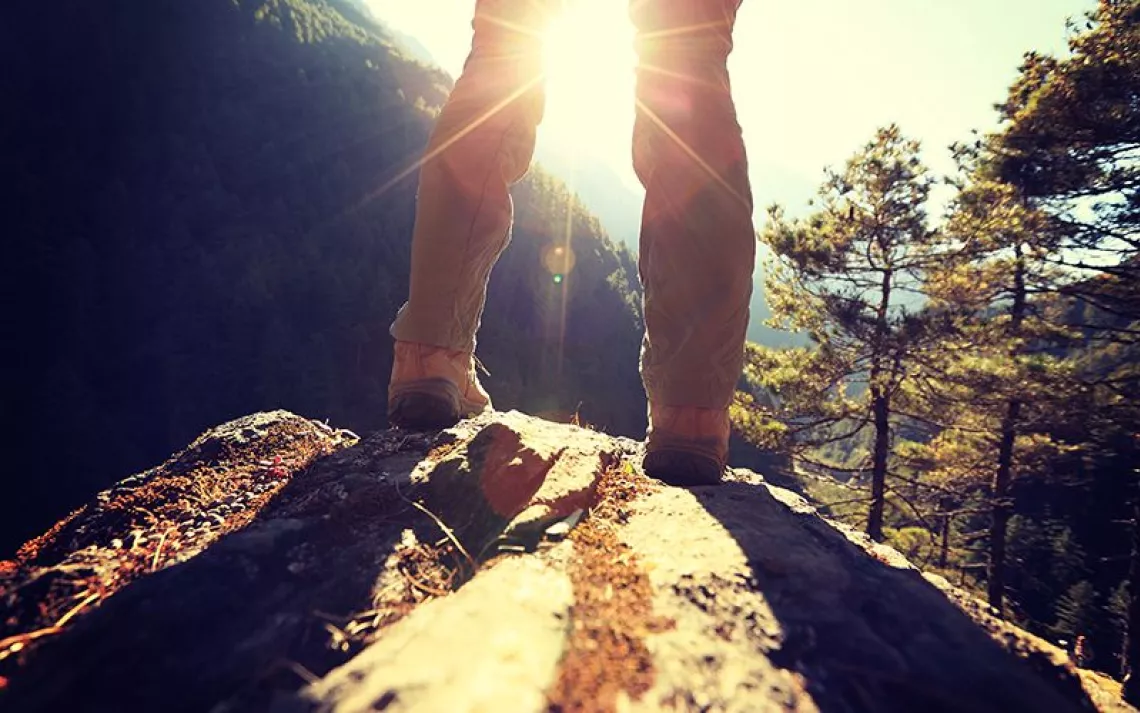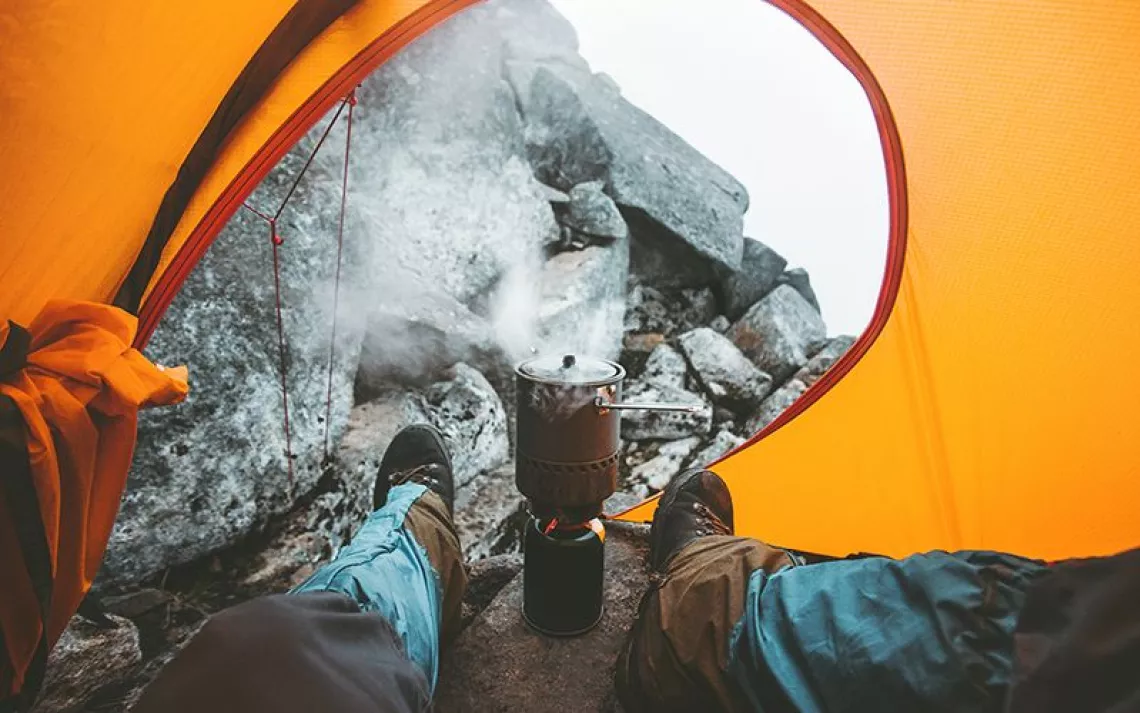A Backpacker’s Theory of Life
What I learned my first summer in the Sierra Nevada—and since
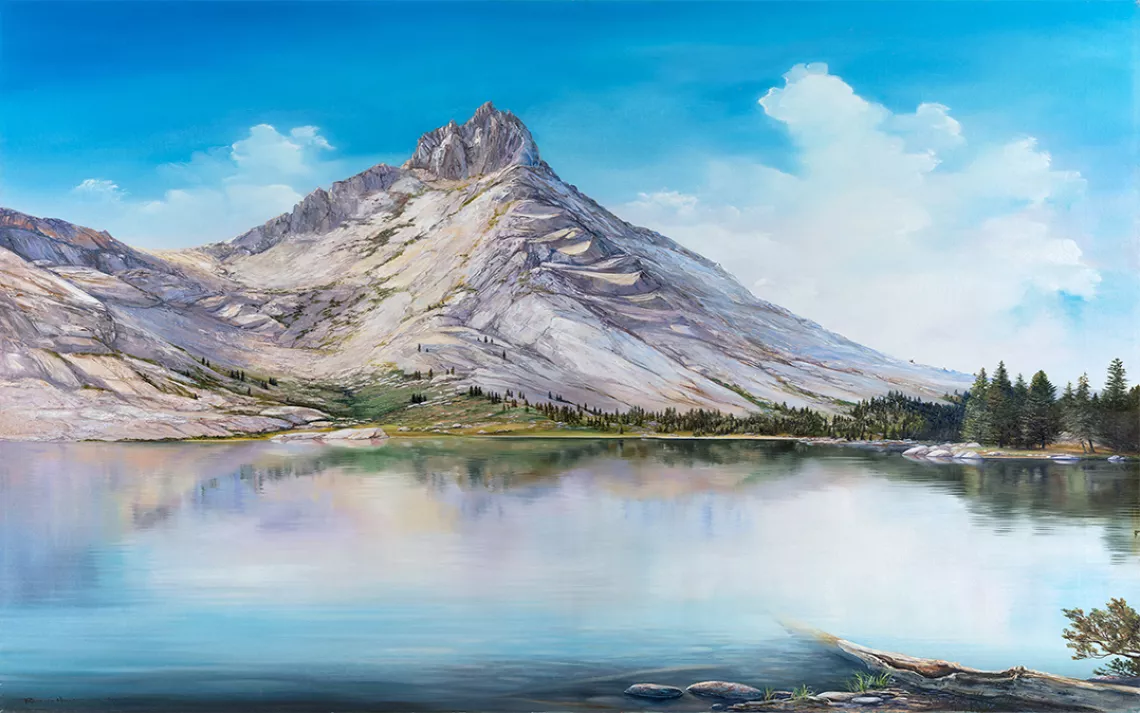
Lower Young Lake. Used with permission of the artist, Rebecca Holland. All rights reserved.
I’m in the autumn of my life now, a first-year baby boomer, not yet retired but given to reflecting on the lessons I’ve learned and where I learned them. Looking back, it seems that the greatest of those lessons—and one applicable to societies as well as individuals—came to me as the result of childhood experiences.
I think of it as the backpacker’s theory of life.
My father passed away recently at the age of 95. When you lose a loved one, you remember experiences together and, for me, a series of such experiences stand out above the rest.
My father loved to hike, camp, and fish, and in June of 1958, when I was 11, he proposed that the two of us go backpacking in Yosemite National Park. It was only a three-day trip but not an easy one. Neither of us knew anything about backpacking, so we carried far too much. My dad brought an axe, a heavy army surplus pup tent, cans of food, and even a cast-iron skillet. My own pack was as big as I was—though, to be fair, I was small and scrawny.
The hike began with a spectacular 2,000-foot climb, past two grand waterfalls, Vernal and Nevada, both roaring at peak volume from the early summer snowmelt. When we reached Little Yosemite Valley, a long and flat, forest-covered area beyond the top of Nevada Falls, I was exhausted. I could have camped right there, in the middle of the afternoon and only five miles in from the trailhead. But my father wanted to push on. At times, he walked ahead of me while I rested and then came back for my pack so I could make it.
We camped that night at a place called Twin Bridges, about nine miles in. It was a lovely spot, with the Merced River churning by not far from our tent. Too tired for dinner, my back and shoulders aching from the pack, I went to sleep even though it wasn’t yet dark, lulled to sleep by the music of the river.
The next morning, refreshed, we left most of our gear in camp and set out for Merced Lake, a four-mile climb over glacier-burnished granite, along the ever-frothing river. It was so much easier to be hiking without a pack, and I was able to keep pace with my father. We returned to camp early that evening to a long and leisurely dinner and hiked back to Yosemite Valley the next day. We’d gone 27 miles in three days with heavy packs, gaining 3,500 feet of elevation, leaving me beaming with a sense of accomplishment. To this day, Yosemite remains my favorite place on Earth.
The next summer, my father wanted to explore some of Yosemite’s higher country. We set off, with packs only slightly lighter than the previous year's, for Young Lakes—three gems set below striking Ragged Peak about seven miles north of Yosemite’s Tuolumne Meadows. The climb to the lowest of the lakes at 10,000 feet still exhausted me.
Far less popular with hikers than the famous Cathedral Lakes south of Tuolumne Meadows, Young Lakes were, for me, even more exquisite. The lowest lake achieves a perfect harmony of lodgepole pines, meadow, beach, shining white granite rocks, and grand nearby summits. Lower Young Lake is still my favorite backpacking destination. My father took me there when I was 12, and I took my son there when he was the same age.
At the age of 13, I started to do some camping without my father, together with my best friend, John Ellsworth. By the end of our first year in high school, my father was convinced that we knew what we were doing and agreed to drive us to Yosemite and let us go backpacking on our own. We weren’t yet 15. John’s parents agreed to pick us up a few weeks later. The only stipulation was that we call home (collect) once a week and send a postcard or two. We each had $20 to buy food and whatever else we might need during our trip. In those days, it was more than enough.
Every summer during high school, I spent several happy weeks with John and other friends hiking Sierra Nevada trails and hitchhiking between trailheads. I recorded all my trips in a small brown book that I still have. Reading through it today, I realize again what a blessed childhood I had, full of the best kind of freedom, which my parents gave me instead of a lot of useless stuff.
Lessons From the Trail
I didn’t realize it until later, but backpacking teaches you about life.
For starters, backpacking offers instruction about the difference between needs and wants. Each time we started a trip, we had to make decisions. That air mattress might be comfortable but it’s extra weight. The stove made cooking easier, but weighed another pound and wasn’t necessary when our camps were below timberline.
Marshmallows? Light enough and tasty by the campfire. Mosquito repellent? We never knew it was there, but we certainly knew when it wasn’t. An axe? Naw—dead wood breaks easily when you hit it over a rock. And those big, light aluminum Sierra Club cups doubled as plates.
Even a tent wasn’t necessary since it never rained at night in the Sierra—well, except for those nights at Rae Lakes and Palisade Lake and.... But we dried out the next morning, anyway. I was learning that you can be happy with very little. More isn’t always better when you must carry it on your back.
You may want the items, but you don’t want the weight. Remember Reese Witherspoon playing Cheryl Strayed in the movie Wild? At the start of her experience on the Pacific Crest Trail, she wants to bring everything but the kitchen sink. When she first tries to stand with her pack on, she falls over. Day after day along the trail, she finds things to jettison, earning her freedom item by item.
Balance Takes Work
Another important lesson that one learns from backpacking: balance.
Not just for you and me, but for our country as a whole.
For the ancient Greeks, balance, that fine point between luxury and deprivation, was the ideal. Buddhism encourages its followers to reduce their wants to be happy. Moderation in all things. Christ commanded his followers to lighten their material burdens.
But America is exceptional—or so we like to think. For us, bigger is better and biggest is best. If something is a good thing, we surmise, then the more of it the better. Supersize me, please. I’ll have the Super Big Gulp, and fries with that. There’s no such thing as enough.
Despite the glorification of unlimited material gain by such figures as Donald Trump, most of us know you can have too much of a good thing. We are way out of balance in America, too rich in stuff and hubris, desperately poor in connection, health, compassion, beauty, leisure time, and self-reflection. Starving and obese at the same time.
As my friend Karin put it in a note to me, “Our consumer society is like the hike from hell, our packs spilling over with gadgets, SUVs, you name it. And at the same time, we can hardly get a good breath because our air is toxic. And still, we think, this is what I want, so I’m going to just keep going full speed ahead.”
In many ways we have too much. Too much work and too much stress from overly busy schedules. Too many calories and too much traffic congestion. Too many weapons. Too much debt. Too much obsolescence—do we really need new phones every year?—and too much speed, so that patience atrophies. And way too much inequality.
And at the same time, we have too little of some of the most important elements of a life well lived. Too little gratitude and not enough empathy. Too little green space and lack of time for leisure and play. Too little community and too little face-to-face connection. Too few spaces for retreat and replenishment. And too little justice.
Less Is More
We have the grossest domestic product on Earth, and yet we are not even among the world’s 10 happiest nations. Our satisfaction with life remains stable or falling, despite decades of steady income growth.
Poverty, especially amid plenty, is not a source of happiness. Our society is filled with have-littles, whose lives would be enhanced by better food, shelter, clothing, education, health care, and financial security. To the contrary, a wealthy elite, with more than they can ever use, demands that the food stamps of the poor be converted, through tax cuts, into private jets for its own pleasure.
If we, as a society, were to heed the core lesson of backpacking—to live in balance—perhaps we wouldn’t fear a massive transfer of wealth from rich to poor. The backpacking ethic also fosters an understanding that the best things in life aren’t things.
On the trails of my youth, we had no iPods or cellphones. A deck of cards provided all the games we needed. We made our own music with songs around the campfire. We had so little but enjoyed so much. With lighter packs, we moved gracefully, finding ourselves out of breath only on the steepest grades. We were free. We had time to be, time to think. We read John Muir, who explored those same trails carrying little more than a blanket, crackers, and tea, and we felt the truth of his words:
“Walk away quietly in any direction and taste the freedom of the
Mountaineer… Nature’s peace will flow into you as sunshine flows into
trees. The winds will blow their freshness into you and the storms
their energy, while your cares drop off like autumn leaves.”
We walked in beauty, as the Navajo say. Beauty above us in the wide crystal sky, beauty below in the fields of colorful wildflowers, beauty before us in mountains, lakes, and waterfalls, in the grand thunderheads and cleansing rain, beauty in the deer that wandered by at dawn and dusk, in the flash of the trout on still water, in the dewdrops on the morning meadows, and in the ever-present song of the white-crowned sparrow.
The memories of those glorious days of my childhood follow me through all the days of my life, their lessons never to be forgotten.
 The Magazine of The Sierra Club
The Magazine of The Sierra Club
